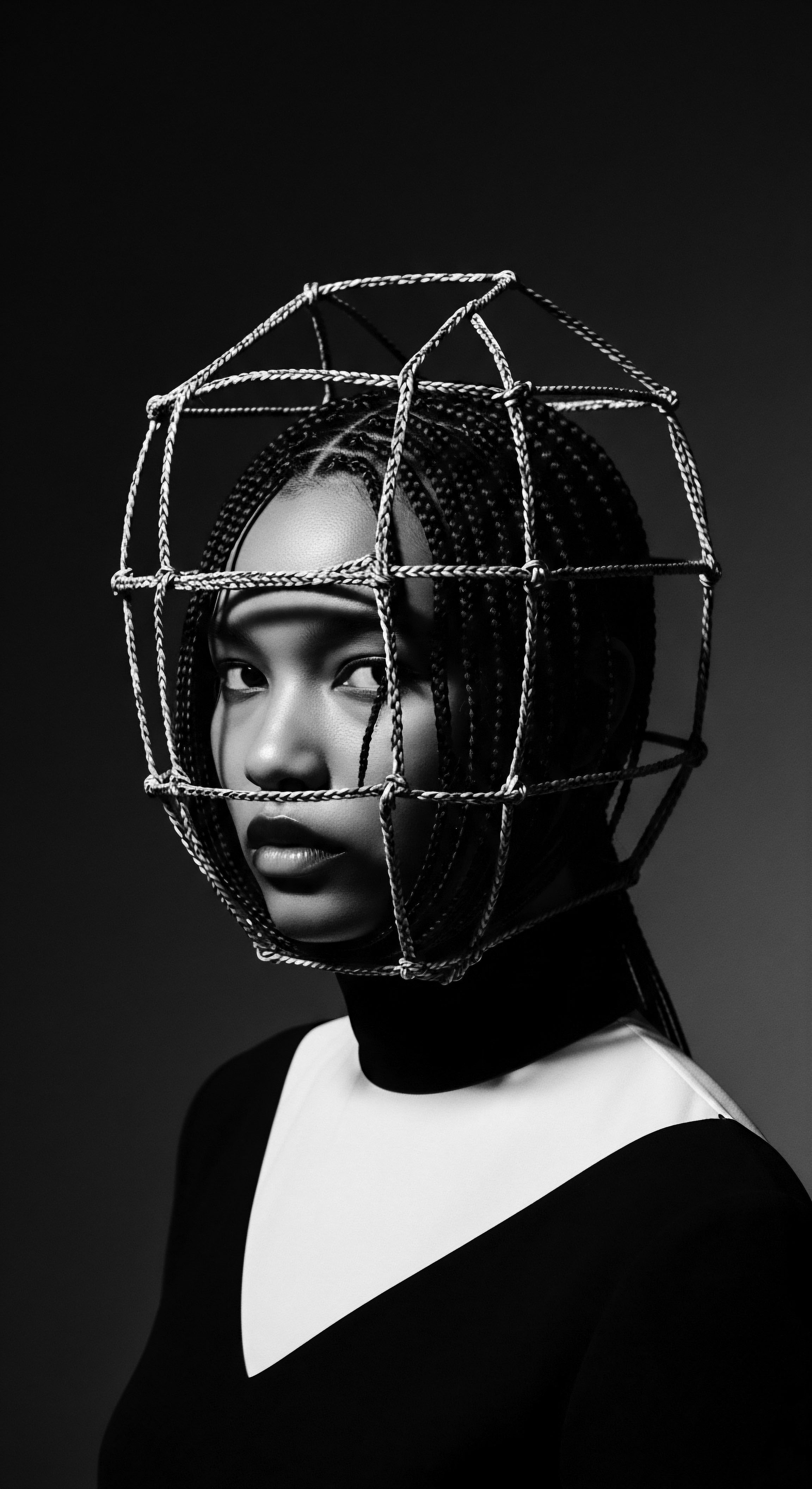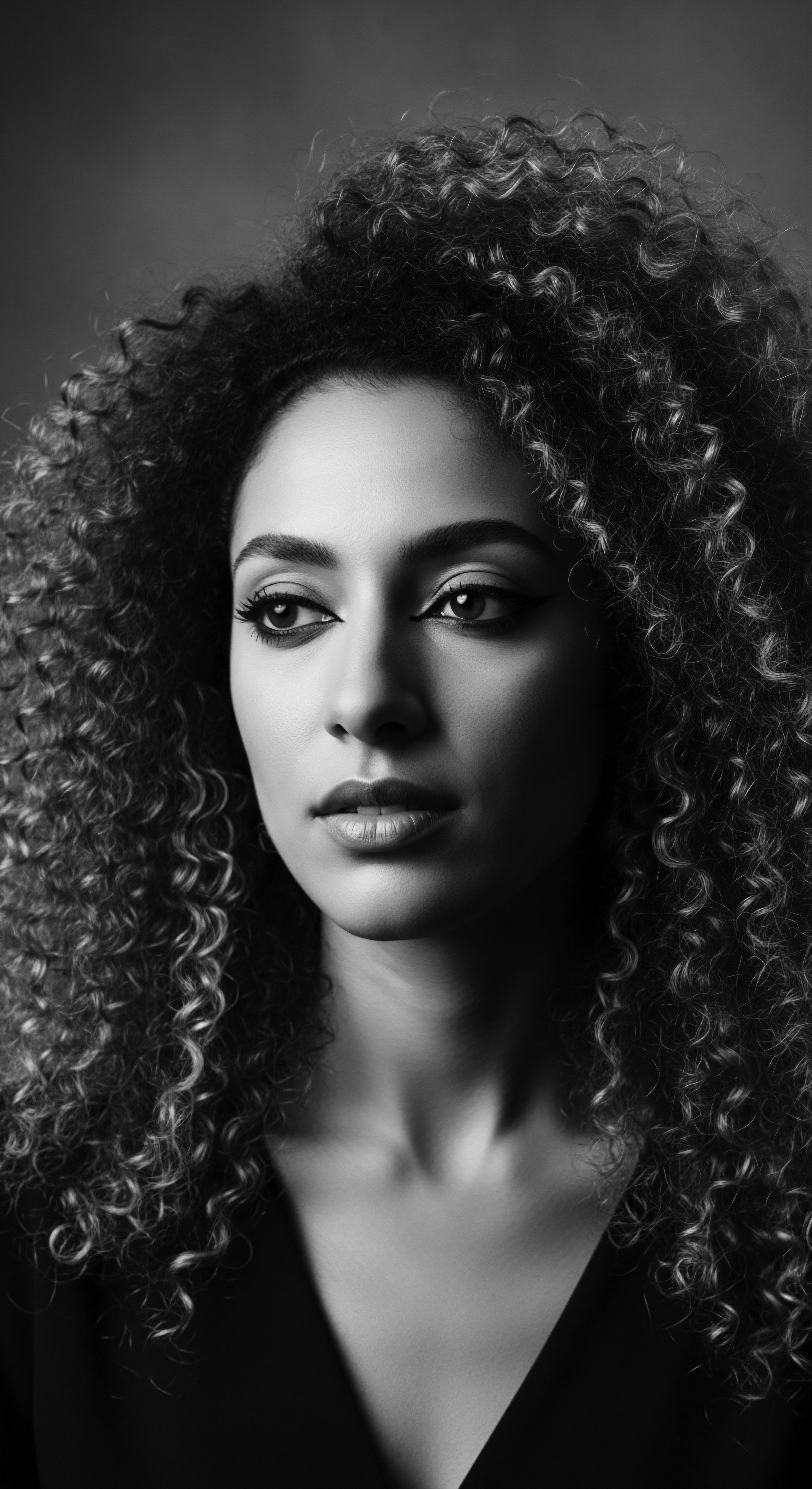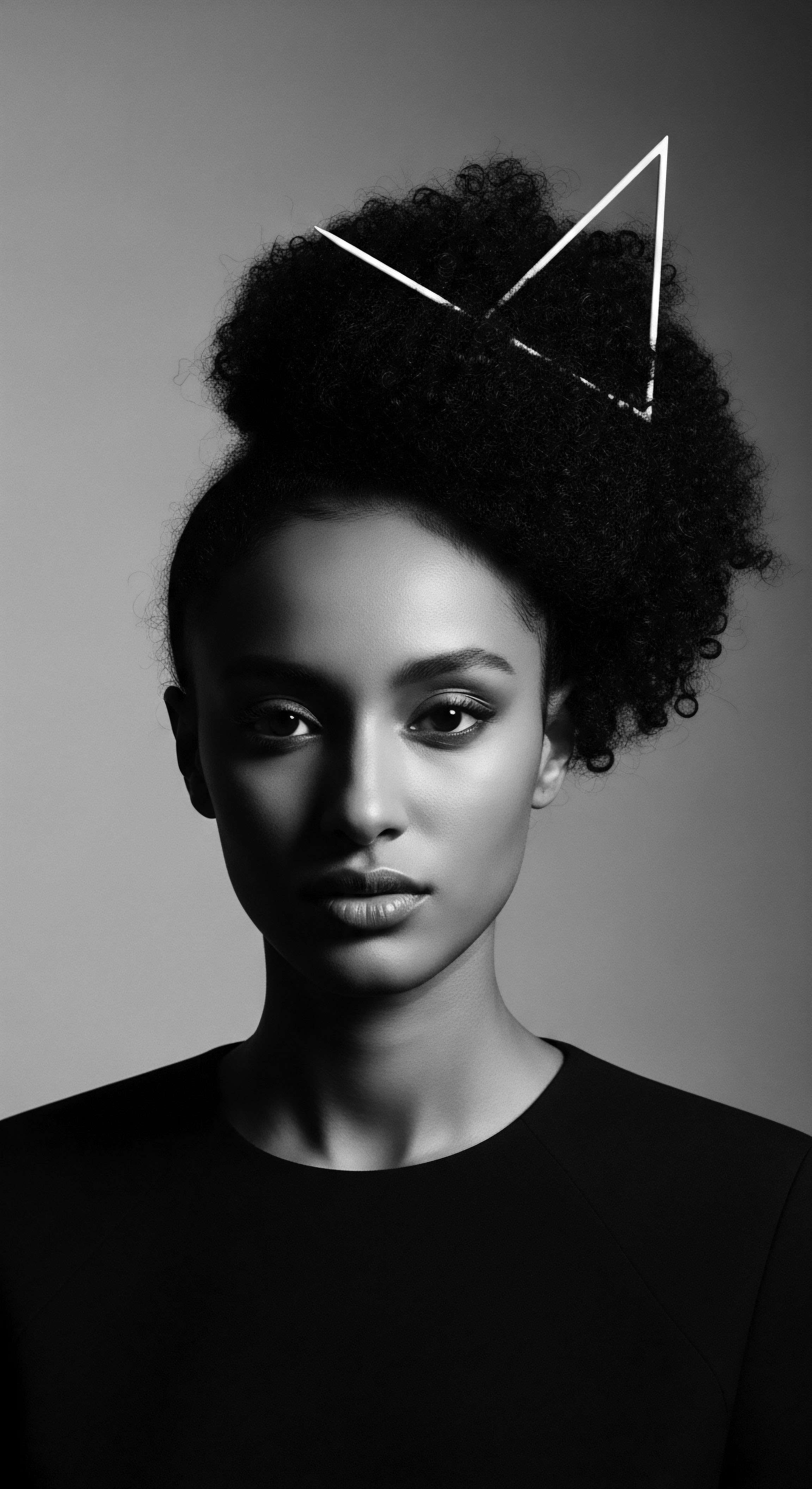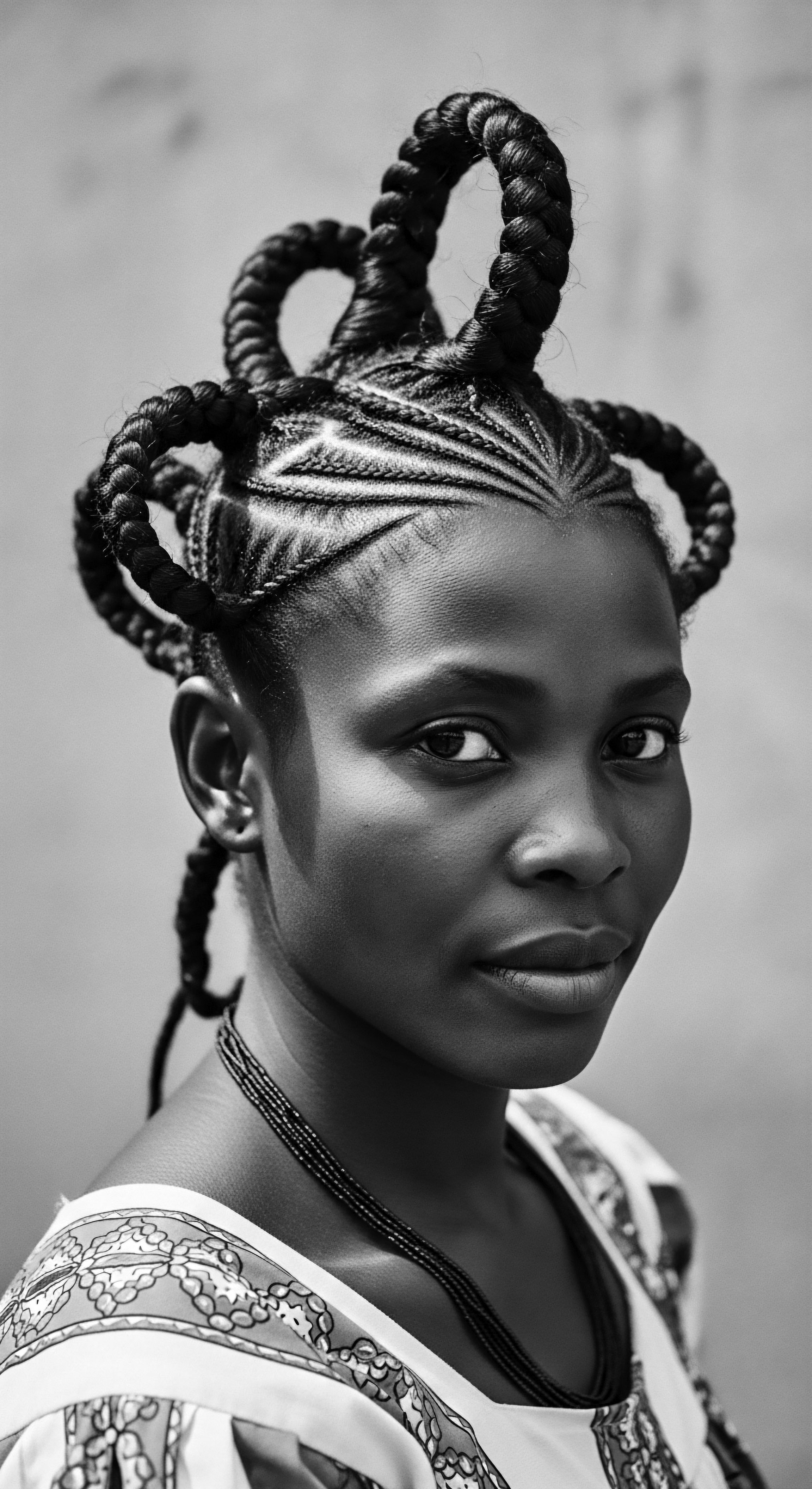
Fundamentals
The concept of Hair Freedom, within the profound expanse of Roothea’s ‘living library,’ represents a foundational understanding ❉ the inherent right and joyous capacity of hair, particularly textured hair, to exist in its authentic, unadulterated state. This designation extends beyond mere aesthetic preference; it signifies liberation from societal pressures, historical impositions, and internalized perceptions that have long sought to constrain, alter, or diminish the natural inclinations of coils, kinks, and waves. It is a declaration of autonomy for each strand, a recognition of its intrinsic worth, and a celebration of its heritage. This initial understanding of Hair Freedom provides a lens through which to view hair not as a challenge to be conquered, but as a living part of one’s being, deserving of reverence and gentle, informed care.
At its simplest, Hair Freedom means allowing one’s hair to be itself, a return to elemental truth. It is a shedding of expectations imposed by external standards that have historically devalued natural hair textures. This definition carries deep resonance for individuals with Black and mixed-race hair, whose ancestral strands have been subject to centuries of scrutiny and control. It involves an active choice to detach from a legacy of forced alteration, embracing instead the rich spectrum of natural forms.

Echoes from the Source ❉ The Strand’s Genesis
To grasp the true meaning of Hair Freedom, one must first look to the very genesis of the strand, tracing its lineage back to the ancestral source. Textured hair, in its diverse expressions, possesses a unique biological architecture. Its elliptical follicle shape gives rise to a helical growth pattern, resulting in the characteristic coils and curls. This structural distinction, while scientifically measurable, also holds cultural significance.
Ancient African societies recognized the uniqueness of their hair, viewing it not as a biological anomaly, but as a direct link to spiritual realms and a marker of identity. The very way hair emerged from the scalp was observed and honored, often seen as a conduit for divine communication.
Early reverence for coils was widespread across the African continent. Hairstyles communicated a person’s age, marital status, social rank, and even tribal affiliation. The care given to hair was often a communal ritual, a time for sharing stories and strengthening bonds.
This historical recognition of hair’s natural form, and the respect accorded to it, forms a crucial part of the heritage underpinning Hair Freedom. It suggests that allowing hair to express its inherent nature is not a modern invention, but a reawakening of ancient wisdom.

The Tender Thread ❉ Simple Cleansing Rituals
The path to Hair Freedom also involves a re-acquaintance with gentle, nurturing care, much like the tender thread that connects generations. Historically, traditional hair care was deeply integrated with natural resources and ancestral knowledge. Simple cleansing rituals, often utilizing plant-derived cleansers and water, honored the hair’s delicate structure and natural moisture balance.
These practices stood in stark contrast to later impositions of harsh chemicals designed to alter texture. The emphasis was on working with the hair, not against it.
Nourishment from the earth played a central role in these ancestral practices. Ingredients like various plant oils, butters, and herbs were applied to keep hair supple, strong, and vibrant. These substances were not merely cosmetic applications; they were part of a holistic approach to wellbeing, acknowledging hair as a living extension of the body and spirit. The deliberate choice of natural ingredients, passed down through oral traditions, underscores a heritage of self-sufficiency and deep ecological connection.
Hair Freedom, at its most fundamental, is the inherent right of each strand to exist in its authentic, unadulterated state, reflecting a deep cultural and historical legacy.

The Unbound Helix ❉ Hair as a First Language
As a living entity, hair has always served as a form of communication, a first language speaking volumes without uttering a word. In ancient societies, hair communicated identity and social standing. A particular style might signify a rite of passage, a declaration of mourning, or a celebratory moment. This symbolic weight meant that hair was never merely decorative; it was a canvas for collective identity and individual expression.
Community bonds were strengthened through shared hair practices. The act of styling hair was often a communal affair, a time for women to gather, exchange news, and transmit knowledge from elder to younger generations. This collective activity reinforced social cohesion and preserved cultural continuity. This shared experience of care and creation is a vital component of Hair Freedom, highlighting how individual expression is often intertwined with communal connection and shared heritage.

Intermediate
The intermediate understanding of Hair Freedom delves into its meaning as a conscious and deliberate act of reclaiming selfhood, cultural legacy, and physical autonomy. It moves beyond simple acceptance to an active affirmation of textured hair’s inherent beauty and strength, recognizing its historical suppression and the ongoing journey toward collective liberation. This concept involves dismantling internalized biases and societal norms that have long dictated how Black and mixed-race individuals perceive and present their hair. It is a profound declaration of identity, rooted in ancestral resilience.
This level of understanding acknowledges that Hair Freedom is not merely a personal choice; it is a socio-political statement. It challenges dominant beauty standards that have historically marginalized afro-textured hair, advocating for its recognition as a valid and celebrated form of human expression. The journey toward Hair Freedom often involves a conscious unlearning of colonial beauty ideals and a re-education about the rich history and science of textured hair.

Echoes from the Source ❉ The Geometry of Coils
The unique geometry of coils and kinks, far from being a flaw, represents a marvel of biological adaptation. Each bend and curve in a textured strand provides structural integrity while simultaneously making it susceptible to dryness and breakage if not handled with reverence. This scientific reality, which distinguishes textured hair from straighter forms, was intuitively understood by ancestral communities. Their traditional care methods were not random; they were carefully developed responses to the specific needs of these hair types.
Ancestral botanical wisdom guided these care practices. Indigenous plants, oils, and clays were chosen for their emollient, strengthening, or cleansing properties, reflecting a deep, empirical knowledge of local flora and its interaction with hair. For instance, the use of shea butter or various plant-based oils in West Africa speaks to generations of observational science, long before laboratories could isolate their beneficial compounds. This intergenerational knowledge forms a significant portion of the heritage that Hair Freedom seeks to honor and reactivate.

The Tender Thread ❉ Braiding as Storytelling
Hair care, particularly braiding, transcended mere grooming; it served as a powerful medium for storytelling and cultural transmission. Each pattern, each design, could convey messages, status, or even historical narratives. The very act of braiding became a communal gathering, a space where traditions were reinforced and knowledge was passed down. This communal aspect of hair care underscores its social importance, creating bonds and fostering a sense of collective identity.
Consider the intricate symbolism found in traditional hair practices:
- Cornrows ❉ Beyond their aesthetic appeal, these tightly woven patterns often served as practical solutions for daily life, keeping hair neat and protected. Historically, during periods of enslavement, certain cornrow patterns were even used as maps to guide escape routes, with seeds sometimes braided into the hair for sustenance.
- Locs ❉ These natural formations, revered in many African cultures, often symbolized spiritual connection, wisdom, and strength. Their development is a testament to patience and a deep acceptance of hair’s organic progression.
- Bantu Knots ❉ A protective style originating from the Zulu people of Southern Africa, these coiled sections of hair offer a means of preserving moisture and defining natural curl patterns. They represent a heritage of resourceful and effective hair management.
Communal hair sessions, often taking hours or even days, were central to these traditions. These gatherings provided a space for shared experiences, intergenerational teaching, and the strengthening of familial and community ties. The time spent in these sessions was not simply about styling hair; it was about preserving cultural memory, fostering belonging, and collectively upholding a legacy of beauty and resilience.
Hair Freedom is an active affirmation of textured hair’s inherent beauty and strength, a conscious act of reclaiming selfhood against historical suppression.
The disruption of these practices, particularly during the transatlantic slave trade, inflicted immense cultural trauma. Enslaved Africans were often forcibly shorn of their hair, a deliberate act designed to strip them of identity and communal connection. This erasure aimed to sever their ties to ancestral traditions and impose a dehumanizing uniformity.
| Aspect of Hair Meaning and Symbolism |
| Pre-Colonial African Societies Signified age, marital status, social rank, tribal identity, spiritual connection. Hair was a sacred part of the body. |
| Post-Colonial / Enslavement Era Dehumanized, associated with inferiority, often forcibly shorn. Pressure to conform to Eurocentric beauty standards. |
| Aspect of Hair Care Practices |
| Pre-Colonial African Societies Communal rituals, natural ingredients (oils, herbs, clays), time-intensive styling as social bonding. |
| Post-Colonial / Enslavement Era Limited access to tools/products, reliance on harsh chemicals for straightening, secrecy in maintaining traditional styles. |
| Aspect of Hair Identity Expression |
| Pre-Colonial African Societies Direct expression of individual and collective identity, a visual language. |
| Post-Colonial / Enslavement Era Hair became a site of oppression, then a tool of covert resistance, and later, overt protest. |
| Aspect of Hair This table highlights the profound shift in the experience of textured hair, underscoring the historical context that makes Hair Freedom a journey of reclamation. |

The Unbound Helix ❉ Adornment and Symbolism
Long before external impositions, hair in pre-colonial African societies served as a powerful medium for adornment and symbolism, speaking volumes about a person’s life and affiliations. Hairstyles were intricate systems of communication, allowing observers to discern an individual’s community role, marital status, age, and even their spiritual beliefs. The Yoruba people of Nigeria, for instance, crafted elaborate designs that honored ceremonial and spiritual occasions, while the Himba tribe in Namibia wore dreadlocked styles coated with red ochre paste, symbolizing their connection to the earth and their ancestors.
The impact of enslavement on hair practices was devastating and intentional. Upon arrival in the Americas, enslaved individuals were frequently forced to shave their heads, a brutal act designed to strip them of their cultural identity and sever their ties to their heritage. This act was a calculated move to reduce them to mere commodities, erasing the visual markers that connected them to their homelands and traditions.
Despite these efforts, hair remained a silent, potent expression of identity. Enslaved Africans continued to wear braids and twists, sometimes even using cornrows to encode messages and map escape routes, demonstrating an extraordinary act of defiance and cultural preservation.

Academic
The academic delineation of Hair Freedom extends into a rigorous examination of its socio-cultural, psychological, and historical dimensions, positing it as a complex phenomenon rooted in the intersection of identity, power, and ancestral memory. This conceptualization recognizes Hair Freedom not merely as a personal preference for natural hair, but as a decolonial practice, a re-assertion of selfhood against a legacy of systemic oppression and Eurocentric beauty hegemony. It is a critical theoretical construct for understanding the agency inherent in hair choices within Black and mixed-race communities, reflecting a continuous dialogue between inherited traditions and contemporary expressions of autonomy.
From a scholarly perspective, Hair Freedom represents a profound shift in epistemic frameworks regarding textured hair. It challenges the historical pathologization of coils and kinks, which were often termed “nappy” or “woolly” by colonizers to deem them inferior to European hair textures. This academic interpretation requires a multidisciplinary approach, drawing from anthropology, sociology, critical race studies, and hair science to construct a comprehensive understanding of its meaning and implications. It compels us to consider the long-term consequences of imposed beauty standards on psychological wellbeing and cultural continuity.

Echoes from the Source ❉ Biophysical Complexities and Genetic Heritage
The biophysical complexities of textured hair provide a compelling scientific foundation for understanding its unique needs and ancestral care. Unlike straight hair, which typically grows from a round follicle, afro-textured hair emerges from an elliptical follicle, causing it to grow in a helical, coiled pattern. This distinct morphology results in fewer cuticle layers, making it more susceptible to dryness and breakage. The natural curves and bends create points of weakness along the hair shaft, requiring specific moisture retention strategies and gentle handling.
This scientific understanding finds remarkable resonance with ancestral wisdom. For generations, African communities developed sophisticated hair care systems that intuitively addressed these biophysical realities. They utilized a variety of natural emollients, humectants, and protective styling techniques, such as braiding and twisting, which minimized manipulation and retained moisture.
The inherited knowledge of plant-based oils, butters, and clays speaks to a deep, empirical understanding of hair biology, passed down through oral tradition and lived experience. This scientific validation of ancient practices underscores the profound connection between genetic heritage and traditional care methodologies.

The Tender Thread ❉ Socio-Cultural Dynamics of Hair Care
The socio-cultural dynamics of hair care rituals within diasporic communities stand as powerful testaments to resistance and resilience. Hair styling sessions were, and continue to be, more than mere grooming; they function as sites of cultural transmission, communal bonding, and identity affirmation. In the face of brutal dehumanization during the transatlantic slave trade, when enslaved Africans were routinely shorn of their hair to strip them of their identity, these practices persisted as acts of defiance.
One compelling historical example that powerfully illuminates Hair Freedom’s connection to textured hair heritage and Black experiences is the strategic use of hair as a tool for survival during the era of enslavement. In Colombia, for instance, enslaved individuals ingeniously utilized cornrow patterns to create maps and convey messages, indicating escape routes or safe houses. This covert communication system, woven into the very fabric of their being, allowed for organized resistance and survival. Moreover, some African women, particularly rice farmers, braided rice seeds into their hair before forced migration, ensuring the survival of essential food sources and cultural continuity in new lands.
(Byrd & Tharps, 2001). This act was not merely practical; it was a profound act of preserving ancestral knowledge and the potential for a future rooted in their own sustenance. This historical instance demonstrates how hair became a clandestine medium for knowledge transfer and collective action, embodying the spirit of Hair Freedom as an act of resistance against overwhelming odds.
Hair care rituals within diasporic communities function as powerful sites of cultural transmission, communal bonding, and identity affirmation, even serving as clandestine tools for survival.
The resilience inherent in these practices underscores the enduring significance of hair as a repository of cultural memory. Despite systematic attempts to erase African identities, the communal gatherings for hair care persisted, albeit often in secret. These moments fostered a sense of belonging and reinforced a collective identity, providing psychological sustenance in an oppressive environment. The continuation of these traditions, often passed down from mothers to daughters, represents an unbroken lineage of care and a quiet, yet potent, form of resistance.

The Unbound Helix ❉ Hair as a Political Statement and Self-Determination
Hair Freedom, at an academic level, is inextricably linked to the concept of self-determination and acts as a potent political statement within the continuum of ancestral legacy. The assertion of natural hair, particularly in the post-slavery and civil rights eras, became a direct challenge to Eurocentric beauty standards that had long dictated what was considered “acceptable” or “professional.” The “Black is Beautiful” movement of the 1960s and 70s, for instance, saw the Afro hairstyle emerge as a powerful symbol of Black pride, unity, and rebellion against prevailing racist norms. This was not merely a stylistic choice; it was a public declaration of self-acceptance and a rejection of the internalized oppression that had compelled many to chemically straighten their hair.
The journey to Hair Freedom is a decolonizing act, dismantling the psychological and social structures that equate proximity to whiteness with beauty or competence. Studies, such as the 2020 Duke University study, have shown that Black women with natural hairstyles are still perceived as less professional and competent, and are less likely to be recommended for job interviews compared to candidates with straight hair. This systemic bias underscores the ongoing struggle and the enduring political dimension of hair choices. The CROWN Act legislation in the United States, aimed at prohibiting discrimination based on hair texture and protective styles, represents a contemporary legal recognition of Hair Freedom as a civil right, a direct response to this historical and ongoing discrimination.
The economic and social dimensions of Hair Freedom are also critical. The rise of the natural hair movement in the 21st century has spurred a new industry, creating opportunities for Black entrepreneurs and providing products tailored to textured hair. This economic agency represents another facet of liberation, moving away from reliance on products designed to alter hair texture to those that nourish and celebrate it. The social aspect involves building communities, both online and offline, where individuals can share experiences, tips, and support on their natural hair journeys, further reinforcing a collective identity.
| Historical Period Pre-Colonial Africa |
| Dominant Hair Narrative / Challenge Hair as sacred, status, identity marker. |
| Manifestation of Hair Freedom Intrinsic Hair Freedom; hair as an unconstrained expression of self and community. |
| Historical Period Transatlantic Slave Trade |
| Dominant Hair Narrative / Challenge Forced shaving, dehumanization, erasure of identity. |
| Manifestation of Hair Freedom Covert resistance ❉ cornrow maps, seeds in hair, secret care rituals. |
| Historical Period Post-Slavery to Mid-20th Century |
| Dominant Hair Narrative / Challenge Pressure to assimilate, "good hair" vs. "bad hair" dichotomy, chemical straightening. |
| Manifestation of Hair Freedom Emergence of Black beauty entrepreneurs; quiet acts of preserving traditional styles. |
| Historical Period 1960s-1970s Civil Rights/Black Power |
| Dominant Hair Narrative / Challenge Rejection of Eurocentric standards, fight for racial equality. |
| Manifestation of Hair Freedom The Afro as a political statement of pride, rebellion, and self-love. |
| Historical Period 21st Century Natural Hair Movement |
| Dominant Hair Narrative / Challenge Reclamation of natural textures, challenge to institutional discrimination. |
| Manifestation of Hair Freedom CROWN Act legislation, diverse natural styles, community building, economic agency. |
| Historical Period This table illustrates the continuous, evolving struggle and triumph of Hair Freedom across distinct historical periods, always rooted in the quest for self-determination. |
The long-term consequences of achieving Hair Freedom extend to mental wellbeing, community cohesion, and cultural preservation. For individuals, embracing natural hair can significantly boost self-esteem and foster a deeper connection to their ancestral lineage. Psychologically, it mitigates the burden of conforming to unattainable standards and reduces the stress associated with hair alteration. At a communal level, the shared journey of Hair Freedom strengthens bonds, creating spaces of mutual support and celebration.
It allows for the intergenerational transfer of traditional knowledge to continue, ensuring that the wisdom of ancestral care practices is not lost but revitalized. Culturally, Hair Freedom contributes to the preservation of diverse Black and mixed-race identities, affirming that beauty exists in myriad forms, all deserving of recognition and respect.
This academic meaning of Hair Freedom therefore is not static; it is a dynamic process of historical recovery, present-day affirmation, and future-oriented liberation. It calls for an ongoing critical examination of power structures and a continuous celebration of the inherent dignity of textured hair, recognizing its profound place in the human story.

Reflection on the Heritage of Hair Freedom
The journey into Hair Freedom, as we have traversed its elemental biology, living traditions, and its role in voicing identity, ultimately culminates in a profound reflection on its enduring heritage. This is not a destination but a continuous flow, a living stream of ancestral wisdom that nourishes the present and guides the future. Each coil, each kink, each wave holds within its very structure the echoes of generations, a silent testament to survival, creativity, and the persistent spirit of a people. The Soul of a Strand whispers stories of resilience, of communal hands tending to crowns under sunlit skies, of clandestine braids carrying messages of liberation, and of defiant Afros rising against oppressive winds.
Hair Freedom, then, is more than a concept; it is a lived experience, a sacred inheritance. It reminds us that our hair is a physical manifestation of our lineage, a vibrant link to those who came before us, and a beacon for those who will follow. The lessons gleaned from ancient practices, the strength drawn from historical struggles, and the joy found in contemporary self-acceptance all contribute to its ever-unfolding meaning.
As we continue to learn, to care, and to celebrate our textured hair, we are not simply engaging in personal grooming; we are participating in a timeless ritual, upholding a precious heritage, and affirming the unbound potential of the human spirit. The path of Hair Freedom invites us to walk with reverence, with knowledge, and with the joyful certainty that our crowns are, and always have been, truly magnificent.

References
- Byrd, A. & Tharps, L. L. (2001). Hair Story ❉ Untangling the Roots of Black Hair in America. St. Martin’s Press.
- Dabiri, E. (2019). Twisted ❉ The Tangled History of Black Hair Culture. Harper Perennial.
- Ellington, T. N. (2020). Black Hair in a White World. The Kent State University Press.
- Johnson, T. & Bankhead, T. (2014). Hair It Is ❉ Examining the Experiences of Black Women with Natural Hair. Journal of Black Studies, 45(1), 4-21.
- Peacock, T. N. (2019). African American Hair and Beauty ❉ Examining Afrocentricity and Identity Through the Reemergence and Expression of Natural Hair in the 21st Century. (Master’s thesis). University of South Carolina.
- Rooks, N. M. (1996). Hair Raising ❉ Beauty, Culture, and African American Women. Rutgers University Press.
- Tate, S. (2007). Black Beauty ❉ African American Women and the Politics of Race and Identity. Ashgate Publishing.
- Thompson, C. (2009). Black women, beauty, and hair as a matter of being. Women’s Studies ❉ An Inter-Disciplinary Journal, 38(8), 831-856.
